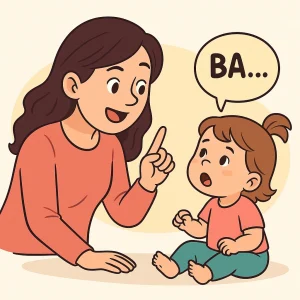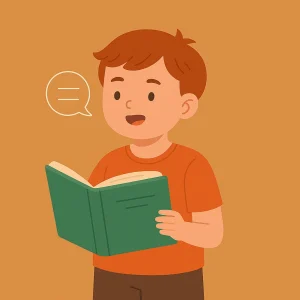Why Does My Child Leave Out Sounds When Speaking?
By Rajini D
Last Updated: January 17, 2025
Have you noticed your child skipping sounds when they speak? This behavior, known as speech sound omission, is not uncommon in early childhood and may indicate a need for intervention. Early detection and support can greatly enhance your child’s communication skills, boosting their confidence and development. In this guide, we’ll uncover why speech sound omission occurs and how you can help. Stay tuned for expert advice and practical strategies to aid your child’s speech journey.
Book You Free Speech Therapy Counselling Now
What is Speech Sound Omission?
Speech sound omission occurs when a child consistently leaves out certain sounds or syllables that should be present in words. This can make their speech difficult to understand for those unfamiliar with their particular pattern of speech. It’s a common characteristic of phonological disorders, where children struggle with the sound rules of speech, leading to omissions and simplifications.
Typically, these omissions become noticeable as children reach the ages where they should be mastering a wide range of sounds. Most children begin to develop clear speech patterns between the ages of 2 and 4 years old. However, if your little one is still consistently dropping sounds past this age range, it might be time to consider whether they need additional support.
Common Causes of Speech Sound Omission
When it comes to speech sound omissions in children, several developmental and physical factors can play significant roles. Understanding these can help you identify the best ways to support your child’s speech development.
Developmental Factors and Their Impact on Speech
From birth, children are on a fast track of development where they learn and mimic sounds around them. During their early years, it’s common for children to simplify complex words by omitting certain sounds—a natural part of speech development. However, if this pattern persists beyond the expected age, it might indicate a developmental delay in phonological awareness or other speech milestones. Factors such as limited exposure to language, inconsistent communication within the environment, or even genetic predispositions can influence this aspect of a child’s development.
The Role of Physical and Neurological Factors in Speech Clarity
Physical issues like hearing impairments can significantly affect a child’s ability to hear and thus replicate sounds correctly, leading to omissions. Regular hearing checks are crucial, especially if speech omissions are noted. Neurological factors also contribute to how children process and produce speech. Conditions such as apraxia of speech—a motor speech disorder—can make it difficult for children to form the correct movements that are necessary for sound production. Disorders in the neurological processing areas related to language and speech can also lead to difficulties in producing clear speech.
Signs Your Child Might Be Omitting Sounds
If you’re tuning into your child’s speech and notice something seems off, you might be wondering if they are omitting sounds. Recognizing the signs early can pave the way for effective intervention. Here are key behaviors and patterns to watch for and understand when it might be time to seek professional help.
Identifying Key Behaviors and Patterns in Speech
Children who omit sounds often display certain speech patterns that can be easy to spot once you know what to listen for. You might hear your child simplifying words by dropping syllables or substituting difficult sounds with easier ones. For instance, they might say “nana” instead of “banana” or “doe” instead of “door.” It’s also common for children to leave out the harder consonant sounds at the beginning or end of words. Pay attention to consistency too—if these omissions are consistent and frequent, it indicates a more persistent issue rather than a simple developmental phase.
When to Seek Help from a Professional
While it’s normal for young children to experiment with sounds and words, persistent omissions by the age of four or older can signify underlying speech development issues. If your child shows frustrations or difficulties in communicating effectively, or if their speech isn’t improving with age, these are clear indicators that professional guidance is needed. Early intervention by a speech-language pathologist can dramatically improve your child’s communication skills, boost their confidence, and support their overall developmental progress.
How Can Speech Sound Omission Impact Your Child?
Speech sound omission can have far-reaching implications for a child’s social interactions and educational growth. Understanding these impacts can help you grasp the importance of addressing speech issues early on, ensuring your child can navigate their world with confidence.
Social Implications for Children Facing Speech Challenges
Children use speech to connect with their peers and express their thoughts and emotions. When they struggle to articulate sounds correctly, it can lead to misunderstandings or difficulty in making friends. Other children may not understand them, or they may become the target of teasing, which can significantly affect their self-esteem and willingness to participate in group activities. Effective communication is crucial for building relationships, and challenges in this area can lead to social isolation and emotional distress.
Know more about on Common Challenges in Child Language Development
Long-term Effects on Educational and Personal Development
The implications of untreated speech sound omissions extend into the classroom, where clear communication is essential for learning. Children with unresolved speech issues may struggle with reading and writing, as both skills are closely linked to sound recognition and production. This can affect their academic performance across subjects and limit their opportunities for success in school and beyond. Moreover, as children grow, their confidence in their ability to communicate can directly influence their career choices and personal growth, shaping their future in profound ways.
Also Read: How Speech Clarity Influences Academic Success in Students
Intervention Strategies for Speech Sound Omission
Addressing speech sound omissions effectively involves a combination of targeted speech therapy techniques and active involvement from parents and caregivers. Here’s how you can support your child’s journey toward clearer speech.
Techniques Used in Speech Therapy to Improve Articulation
Speech therapists employ various techniques to help children improve their articulation abilities, addressing speech sound omissions directly. One common method is auditory discrimination training, which helps children hear the difference between sounds they can and cannot produce. Another technique involves phonological training, where therapists use games and activities to focus on specific sounds that are challenging for the child.
Articulation therapy might include demonstrating how to move the tongue to produce certain sounds. This is often complemented by visual aids, such as mirrors, to show the child how their mouth moves when making sounds. Repetition plays a crucial role; therapists engage children in drills to practice sounds, words, and eventually sentences that incorporate the targeted sounds.
Role of Parents and Caregivers in Supporting Speech Development
The role of family involvement cannot be overstated when it comes to reinforcing the benefits of speech therapy at home. Parents and caregivers are encouraged to create a supportive communication environment. This can be done by reading stories aloud, which not only provides clear examples of speech sounds but also enhances the child’s vocabulary and syntax understanding. Engaging the child in conversation throughout the day about their activities and interests also promotes speech practice in a natural setting.
Conclusion
Addressing speech sound omission early is crucial for your child’s clear communication and confidence. If you notice your child struggling with speech, it’s important to seek help from a speech therapy professional. At Wellness Hub, our expert speech therapists are ready to support your child with personalized care. Don’t wait to take action; early intervention can make a big difference.
Frequently Asked Questions:
1. What is speech sound omission?
Speech sound omission occurs when a child consistently leaves out certain sounds or syllables when speaking, which can affect their ability to be understood.
2. At what age should I be concerned about my child omitting sounds?
Concerns should arise if your child is still omitting sounds by the age of 4, as most children should have developed clearer speech patterns by then.
3. Why does my child leave out sounds when talking?
This can be due to developmental reasons, physical issues like hearing problems, or neurological factors affecting their ability to produce certain sounds.
4. How can speech therapy help with sound omission?
Speech therapy can help by teaching your child how to articulate sounds correctly through various exercises and techniques tailored to their needs.
5. What can I do at home to help my child with speech sound omission?
Engage your child in reading and talking activities daily, and practice the specific exercises recommended by your speech therapist.
6. When should I seek a professional for my child’s speech issues?
If your child’s speech isn’t improving with age, or if they show signs of frustration when communicating, it’s a good idea to consult a speech therapist.
7. Can speech sound omission affect my child’s academic performance?
Yes, it can impact their reading and writing skills, which are crucial for academic success, making early intervention important.
8. What are common signs of speech sound omission in children?
Common signs include dropping syllables, substituting difficult sounds, and consistently mispronouncing words.
9. Is speech sound omission the same as stuttering?
No, they are different; speech sound omission involves missing specific sounds, while stuttering is characterized by repeated sounds or interruptions in speech.
10. How long does it take to correct speech sound omission?
The time it takes can vary based on the child’s age, the severity of the omission, and how consistently the therapy and home practices are applied.
About the Author:
Rajini Darugupally
M.Sc., Speech-Language Pathologist (9+ years of experience)
Rajini is a passionate and dedicated Speech-Language Pathologist with over 9+ years of experience, specializing in both developmental speech and language disorders in children and rehabilitation in adults. Currently, at Wellness Hub, she thrives in a team environment that values innovation, compassion, and achieving results for their clients.
Book your Free Consultation Today
Parent/Caregiver Info:
Client’s Details:
* Error Message








